Dubbed vs Original: Which Spaghetti Western Version to Watch?

You're about to settle in for "The Good, The Bad and The Ugly," but wait—which version should you choose? The original Italian production with English dubbing preserves Leone's raw vision, while the 2002 restoration offers crisp audio and visual enhancements. It's not just about subtitles versus dubbing; it's about experiencing these films as their creators intended versus how modern technology can present them. The choice affects everything from character nuance to atmospheric authenticity.
The History of Dubbing in Spaghetti Westerns
While many filmgoers enjoy Clint Eastwood's iconic performances in classics like "The Good, The Bad and The Ugly," few realize they're watching a film that was created almost entirely without live sound. This practice was standard for Sergio Leone and other directors creating Italian and European Westerns in the 1960s.
On set, actors often delivered lines in their native languages—English, Italian, or Spanish—knowing their voices would be dubbed later in post-production. When you watch the English version, you're hearing voice actors replacing the original Spanish and Italian supporting cast. Conversely, Italian audiences experienced a completely different soundtrack where even Eastwood's lines were replaced by Italian voice actors.
This multi-language production approach became a defining characteristic of Spaghetti Westerns, creating unique viewing experiences for different international audiences. This technique is quite different from the rich dialogue excellence demonstrated in 1930s cinema, when the advent of sound films revolutionized how emotions and relationships could be conveyed on screen.

Understanding Production Methods in Leone's Films
The dubbing practices in Spaghetti Westerns reflect a deeper production philosophy that shaped Sergio Leone's distinctive filmmaking approach. When you watch his Italian movies, you're experiencing a unique creative process that prioritized visual storytelling over synchronized sound.
Leone shot scenes without recording dialogue, freeing him to focus on ambitious visual elements. Actors often spoke their native languages on set—English, Italian, or Spanish. Post-production dubbing created multiple dub versions for international audiences. Neither English nor Italian dubbed versions can be considered definitive director's cuts. The 2002 restoration offers yet another audio option with Eastwood and Wallach re-recording their dialogue.
This production method explains why you might notice slight mismatches between lip movements and dialogue, but it's this very technique that allowed Leone's visual genius to flourish. Leone's approach contrasted sharply with the Hays Code restrictions that dominated mainstream Hollywood filmmaking during this era.
How Multiple Languages Shaped Filming Practices
Why did Leone's sets often sound like the Tower of Babel? Unlike traditional Westerns, Spaghetti Westerns brought together actors speaking Italian, Spanish, English, and other native languages simultaneously. This multilingual approach fundamentally changed how scenes were shot.
You'll notice actors were frequently filmed separately based on language groups, with American stars rarely sharing actual dialogue with their European counterparts. Directors knew post-production dubbing would eventually unify everything, so they prioritized visual composition over audio quality. This practical solution to budget constraints allowed for international distribution without hiring exclusively bilingual actors.
When you watch these films today, the sometimes imperfect lip synchronization reveals this unique production method—a distinctive feature that reminds you of the genre's resourceful European origins. This approach to filmmaking shares similarities with Japanese cinema's Golden Age techniques, where visual storytelling often transcended language barriers to reach international audiences.

The Controversy Around "The Good, The Bad and The Ugly" Dubs
Perhaps no Spaghetti Western better exemplifies these multilingual production challenges than "The Good, The Bad and The Ugly," which remains at the center of an ongoing dubbing controversy. Sergio Leone's masterpiece exists in multiple audio versions, making it difficult to determine which is definitive.
The film has at least three different dubs—English, Italian, and Spanish—each replacing different actors' voices. In 2002, Clint Eastwood and Eli Wallach re-recorded their dialogue for the restoration. Lee Van Cleef's voice was replaced by a different actor in the 2002 version. Neither the English nor Italian dub can be considered the authoritative director's cut. You can experience different versions by seeking out the Italian, Spanish, or 2002 restoration.
Voice Acting Quality: Original vs. Dubbed Performances
Voice performances in spaghetti westerns present a fascinating paradox, as virtually every character you see onscreen has been dubbed—sometimes multiple times across different versions. The production method resembled silent film techniques, with actors later adding their voices in post-production.
When watching these Western movies, you'll notice varying dubbing quality between versions. While Clint Eastwood spoke English in the original release, supporting actors performed in their native Spanish or Italian, creating unavoidable disconnects. The 2002 restoration attempted to recapture iconic moments with original actors, though Lee Van Cleef's performance required a substitute voice actor.
You'll find passionate debates among fans about which language track delivers the profoundly genuine experience. The choice matters because dubbing drastically impacts performances, potentially enhancing or diminishing the intensity that makes these films legendary.
Artistic Intent: What Leone Wanted Audiences to Experience
Few filmmakers embraced the limitations of their production circumstances as creatively as Sergio Leone did with dubbing. When you watch his spaghetti westerns, you're experiencing his deliberate choice to prioritize visual storytelling over perfect audio synchronization.
Leone's artistic vision placed cinematography and editing above matching lip movements. He leveraged dubbing as a tool to capture more ambitious shots and stunts.
The auditory experience was secondary to the visual impact he wanted you to feel. He didn't view dubbing as a compromise but as a practical filmmaking technique.
Without audio recording constraints, Leone could focus on creating his distinctive visual style.
This approach means there's no single "correct" version of films like The Good, The Bad And The Ugly—whether you choose Italian, English, or the 2002 re-recording, you're still experiencing Sergio Leone's core visual intention.
Modern Restorations and Their Impact on Viewing Choices
Authenticity has become a complicated concept for fans of spaghetti westerns in the digital age. When you stream Sergio Leone's classics today, you're likely watching one of several restoration versions with varying audio and visual quality. The Good, The Bad and The Ugly's 2002 restoration, for example, mixes original and re-recorded dialogue, challenging the notion of a "definitive" Western movie experience.
These restorations give you unprecedented options to experience spaghetti westerns as they might've been seen in different countries. You can switch between the Italian dub, English versions, or even compare multiple restoration approaches to the same movie's content. While these choices enhance accessibility, they also require you to decide what version best represents the authentic spirit of Leone's vision.
Choosing the Right Version for Your Viewing Experience
Selecting the ideal version of a spaghetti western requires understanding what you value most in your viewing experience. When deciding how to watch "The Good, the Bad and the Ugly," consider your priorities:
- For authenticity enthusiasts: The Italian dub offers the director's original vision, though you'll miss Clint Eastwood's iconic voice
- For English-speaking purists: The original English dub preserves Eastwood, Wallach, and Van Cleef's performances
- For modern audio quality: The 2002 restoration features re-recorded lines by Eastwood and Wallach (though Van Cleef's voice is replaced)
- For historical context: Experiencing different dubs helps appreciate the international nature of Spaghetti Westerns
- For completists: Watch all versions to understand how dubbing affects the film's tone and character dynamics



